The Nuanced Connection Between Your Food Struggles and Attachment Wounds
One thing I often say in session with clients is that our challenges with food are a symptom, not the problem. That’s because at the core of any type of fixation lies a disconnection from self.* And that disconnection most commonly results from attachment wounds (or relational trauma) in childhood. In this article — the first in a four-part series — we’ll uncover what attachment wounds are and how they lead to disconnection from self and briefly introduce the concept of enmeshment.
Relational Trauma: Attachment Wounds in Childhood
Most of us have experienced some kind of emotional wounding from relationships. And the early wounds that occur in childhood have the biggest impact in our adult lives.
Attachment bonds — or the type of bond formed as a result of interactions between us and our primary caregivers — create a blueprint we carry with us, playing a crucial role in our emotional development. This blueprint is the subtle, invisible underworld of our psyche. It’s born out of the repeated relational patterns we’re a part of in the family system and affects the relationships — romantic and otherwise — we have as adults. In other words, the ways in which parents consistently or inconsistently attune to our emotional and physical needs dictate how we show up in future relationships, including the relationship we have with food and ourselves.
However reliable, suffocating, controlling, chaotic, dismissive, or unpredictable this attachment with our parents was, the resulting blueprint shapes our view of the world and what we need to do to be seen, accepted, and feel like we matter. It informs how safe and secure, anxious, or avoidant we generally feel in relationship and in conflict and it forms the core beliefs we hold about our okayness, worthiness, and goodness. Whether we deserve and trust love and good treatment from others and how we need to act and who we need to be to belong and feel worthy in relationship all come back to attachment bonds. Below are examples of behaviors that reflect the type of blueprint and core beliefs we carry.
We tiptoe around others, suppressing our needs because we’re afraid of rocking the boat.
We please and appease to stay in peoples’ good graces.
We overfunction and give and give because we believe that’s what we have to do to earn love.
We put on a happy face no matter what to protect our vulnerability.
We keep people at a distance for fear of intrusion.
We often don’t know this blueprint operates in the background until we do. In the meantime, the unresolved wounds in the blueprint cast a shadow that looks for things to cast itself onto. It manifests as exaggerated or disproportionate reactions and the anxious or avoidant ways in which we unconsciously attach to our partners, friends, children, food, things, and idealized versions of ourselves. When we ignore these wounds, we disown a younger, more vulnerable part of us that needs care. Disowning this injured part means we split off from it, push it down, and pretend it doesn’t exist. We say, “it’s all in the past.” Except it’s not —it continues to exist today with its very own energy and life force inside of our nervous systems, psyches, hearts, and spirits, playing out in our everyday life.**
The Spectrum of Emotional Wounds
Most of my clients experienced some form of emotional misattunement in their childhood that plays out in unwanted behaviors today. Here are ways misattunement might show up in childhood:
Your feelings and self-expression are shamed and shut down, tuned out and dismissed, invalidated, or gaslit.
You’re manipulated, belittled, subjugated, patronized, ignored, yelled at, or criticized.
You’re at the mercy of an oppressive, black-and-white, authoritarian parent.
You are bullied, picked on, coerced, or abused by siblings.
You become the little adult in the family, tiptoeing around and catering to an emotionally immature parent — setting aside your own needs in the process.
You experience what’s called enmeshment with a parent, meaning your sense of self is stifled, tethered, and clipped by the anxious intensity of the overcare and attention you receive.
This is not an exhaustive list! Let me know in the comments if you experienced a form of misattunement not listed, and I’ll add it.
Any well-intentioned parent can invalidate or dismiss a child on occasion when they’re triggered, frustrated, distracted, or impatient. However, emotional wounds form when the above examples of misattunement occur in a chronic, systematic pattern. The last example of misattunement, enmeshment, is where we’ll focus most of our attention for the rest of this series.
Even if you don’t think you experienced enmeshment trauma, I encourage you to join me each month as we explore the signs of parent-child enmeshment and how it relates to food struggles. The emotional and developmental impact — and ways to heal — are similar regardless of the type of relational or attachment trauma experienced. I hope you find something useful here.
*Fixation may look like obsessing over, bingeing on, depriving of, or orienting your life and emotions around food or another focus like exercise, substances, a relationship, sex, or productivity.
**See this article to learn more about working with emotions in the body and settling the nervous system.

